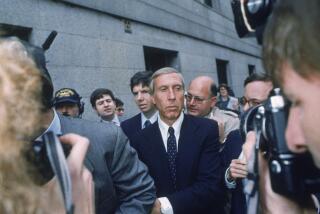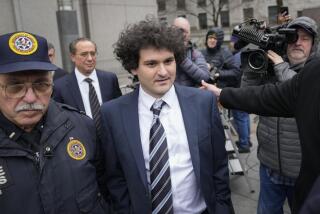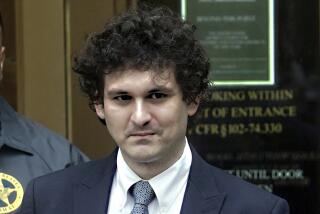Enron Jury Saw Story Defense Missed
- Share via
HOUSTON — Kenneth L. Lay was in no hurry to update his Internet site Friday.
The home page, with its red, white and blue piping and its formal portrait of the disgraced Enron Corp. founder, remained a digital time capsule of the moment when the verdict was still pending, when Lay could still spit defiance at the government’s attacks on his character, when he could still write: “We firmly believe that the jury will see through this.”
Instead the jury saw through Lay and former Enron Chief Executive Jeffrey K. Skilling, finding them guilty Thursday of conspiracy and fraud charges that could put the two men behind bars for much of the rest of their lives.
The jurors, working people all and many in positions of substantial responsibility, compared their own working lives with those of the defendants and, perhaps surprisingly, found they had some things in common.
True, most of the jurors’ desk calendars for a week in February 1999 probably didn’t read: “Davos, Paris, London, Mumbai,” as Lay’s did. But the trappings didn’t keep them from understanding the fundamentals of Lay and Skilling’s jobs and the culture at Enron.
And that was a big problem for the defense.
During closing arguments last week, Daniel M. Petrocelli, Skilling’s top lawyer, said the trouble with the government’s case was that “they don’t have a story to tell. There is no story here.”
The prosecutors, he said, couldn’t build a narrative around the supposed conspiracy at the core of their case. When did it start? Where was it hatched? Who was in on it? In place of a story line, Petrocelli said, the government offered “a hodgepodge of issues -- a little broadband statement here, a little retail resegmentation here, a little spec trading over here. What kind of a case is that?”
Yet the jurors seemed to find a powerful story in the Enron trial, as did others touched by the energy company’s collapse.
Not that it was an easy tale to grasp. Juror Wendy Vaughan, a small-business owner, likened it to “a puzzle with about 25,000 pieces dumped onto the table.”
For John E. Olson, Enron was a story about overreaching.
Olson didn’t testify during the four-month trial, but some of his warnings were mentioned. As a natural-gas industry analyst for what is now Credit Suisse First Boston, Olson got to know Ken Lay in the late 1980s, when Enron was about to transform itself from a tortoise into a hare.
Enron, the leading gas supplier to the Midwest, “had the potential to grow 5% a year, or, with price increases and diversification, maybe 10%,” Olson said Friday.
Lay wanted more. With the success of its new gas-trading business -- brainchild of a whip-smart young McKinsey & Co. consultant named Jeff Skilling -- Lay saw a chance for Enron to become a hot growth stock like a software house or a biotech firm. If Enron could deliver consistent double-digit profit increases, Wall Street would love the story and the stock would explode.
“Mr. Lay defined a growth mandate of 15% a year,” Olson said. “But they had to cheat to get there.”
Olson never bought the Enron story. He gave the stock a tepid recommendation at Credit Suisse First Boston, and when he moved to Merrill Lynch & Co. in 1992, he was still lukewarm. His resistance raised hackles at Merrill, as it had done at CSFB. Lay, Olson said, was unwilling to give lucrative investment banking business to a firm that didn’t rate his stock a “strong buy.”
Merrill fired Olson in 1998 and ramped up its business with Enron. Three former Merrill bankers are in prison now in connection with an Enron deal, and a fourth is free pending appeal. Merrill also faces damages that could top $100 million from Enron-related civil suits.
Olson, who now works for a Houston-based investment firm, said the sordid details that came out during the trial -- the scramble to pad earnings at the end of each quarter, the strange transactions with off-the-books partnerships run by former Chief Financial Officer Andrew S. Fastow, the frantic hyping of Enron’s new ventures into broadband trading and retail electricity sales -- all flowed from Lay’s high-growth fiat.
So did the corporate culture at Enron, which former employee Ken Norton described as “very intense, very, very deal-driven.” For him it was a story about haywire incentives.
Norton, who lost his job and hundreds of thousands of dollars of retirement savings when Enron failed, recalled the atmosphere in Enron’s risk assessment and control operation, where he worked as a financial analyst. A business developer would come to RAC with paperwork on a deal -- a long-term contract to supply heat and power to a big-city school system, say -- and RAC’s number crunchers would figure out what the contract was worth.
“While the ink was hardly dry, they were getting a bonus” based on the presumed value of the deal, Norton said Friday. The system led deal makers to put a lot of pressure on the risk managers to inflate the numbers. And once a deal was booked, it was somebody else’s job to make sure the lights stayed on at the schools.
“There was no long-term responsibility,” said Norton, a Houstonian who, in an odd way, owes his new job to his old company. He works for a consulting group that helps companies comply with Sarbanes-Oxley, the 2002 reform law prompted by the Enron collapse.
Responsibility was a touchstone for jurors who spoke during an unusual group news conference Thursday, an hour after the verdicts were delivered.
A number of jurors mentioned the challenges they faced in their own workplaces, especially during the months that the Enron trial chewed up most of their time.
Several said they could identify with the workplace dynamics at Enron even if their own jobs were far different.
“I think our employers will get better employees back,” said Deborah Smith, the jury forewoman and a human-relations worker for an oil-services company.
Freddy Delgado, an elementary school principal, showed little patience for Lay and Skilling’s claim that they shouldn’t be blamed for wrongdoing that went on behind their backs.
“I can’t say I didn’t know what my teachers were doing in the classroom,” he said. “I’m still responsible if a child gets lost.”
More to Read
Inside the business of entertainment
The Wide Shot brings you news, analysis and insights on everything from streaming wars to production — and what it all means for the future.
You may occasionally receive promotional content from the Los Angeles Times.










